人教版(2019)选择性必修第一册 Unit 5 Working the Land 单元知识清单课件 (14) (2)
文档属性
| 名称 | 人教版(2019)选择性必修第一册 Unit 5 Working the Land 单元知识清单课件 (14) (2) | 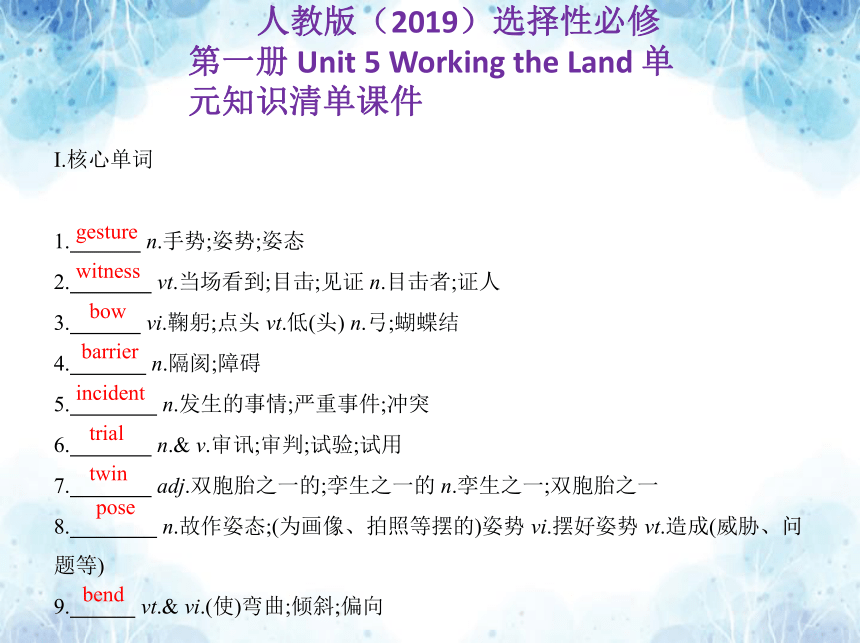 | |
| 格式 | pptx | ||
| 文件大小 | 211.5KB | ||
| 资源类型 | 教案 | ||
| 版本资源 | 人教版(2019) | ||
| 科目 | 英语 | ||
| 更新时间 | 2022-09-28 06:49:51 | ||
图片预览


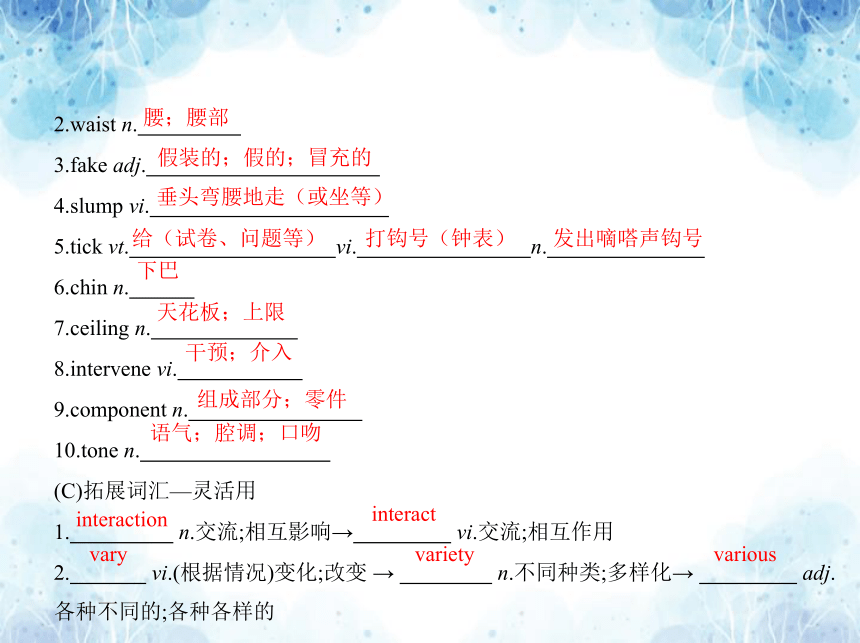
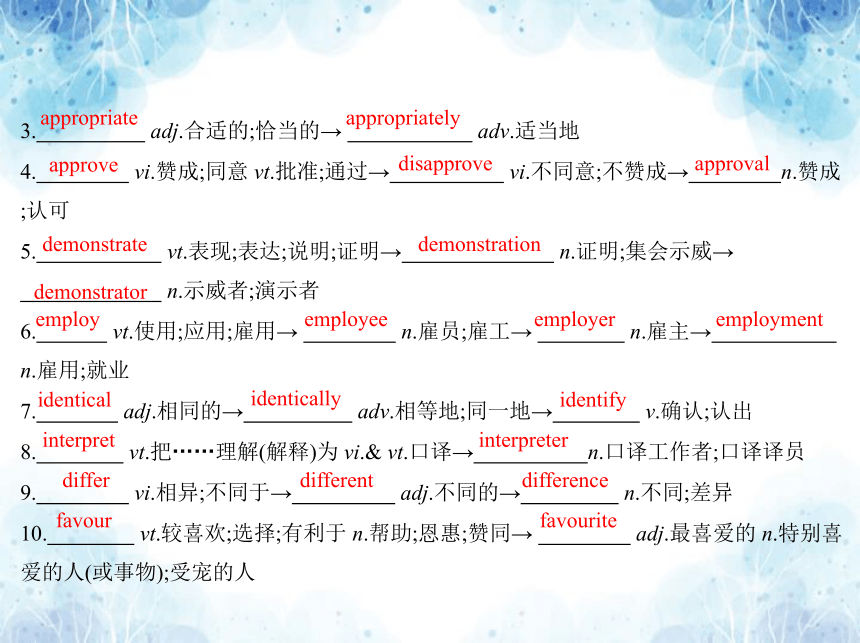

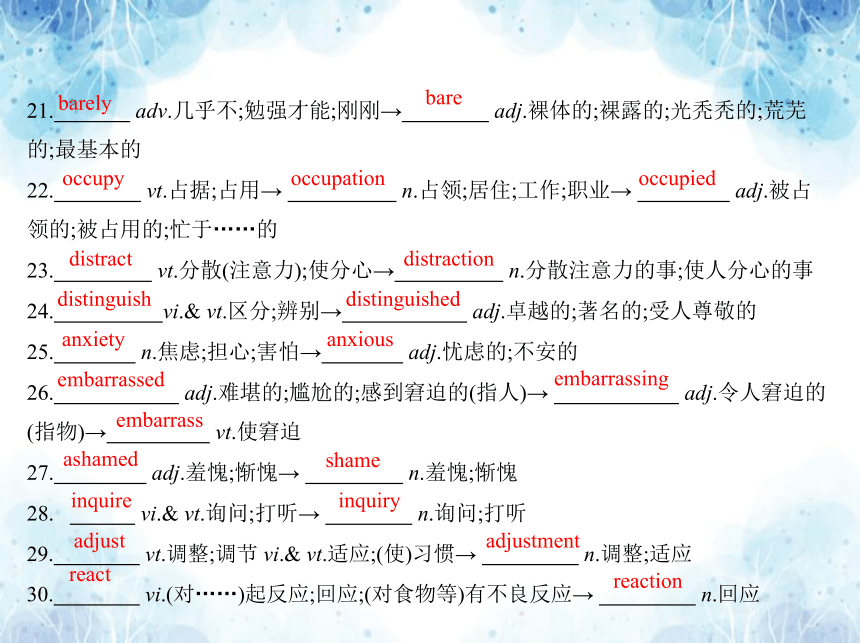
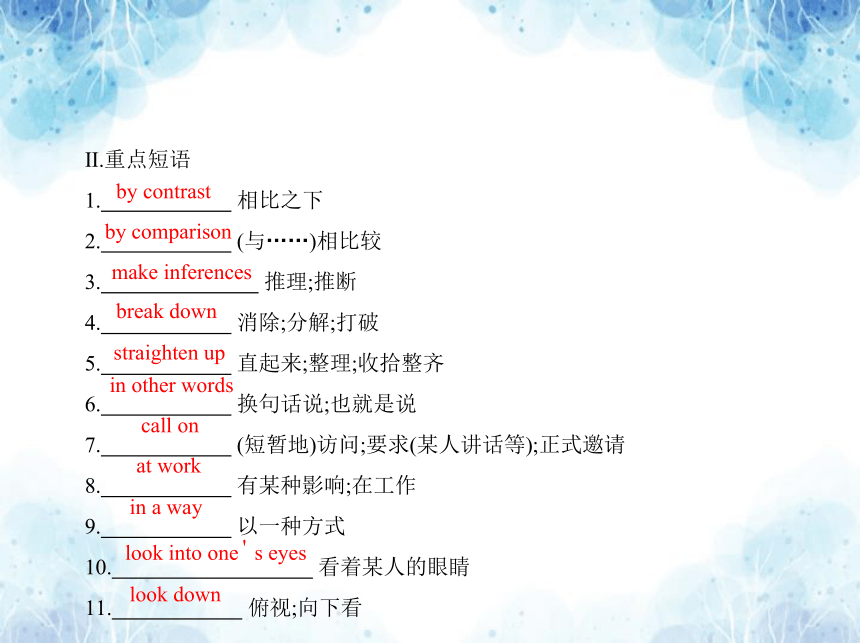
文档简介
(共16张PPT)
Ⅰ.核心单词
1. n.手势;姿势;姿态
2. vt.当场看到;目击;见证 n.目击者;证人
3. vi.鞠躬;点头 vt.低(头) n.弓;蝴蝶结
4. n.隔阂;障碍
5. n.发生的事情;严重事件;冲突
6. n.& v.审讯;审判;试验;试用
7. adj.双胞胎之一的;孪生之一的 n.孪生之一;双胞胎之一
8. n.故作姿态;(为画像、拍照等摆的)姿势 vi.摆好姿势 vt.造成(威胁、问
题等)
9. vt.& vi.(使)弯曲;倾斜;偏向
gesture
witness
bow
barrier
incident
trial
twin
pose
bend
人教版(2019)选择性必修第一册 Unit 5 Working the Land 单元知识清单课件
10. vt.揭示;显示;露出
11. vt.意味着;暗示
12. vi.盯着看;凝视 n.凝视
13. vt.察觉;看待;理解
14. n.胸部;胸膛
15. adv.只是;仅仅;只不过
16. vi.& vt.费心;麻烦;因……操心 n.麻烦;不便
17. vi.& vt.哭泣;流泪
18. n.矛盾;冲突 vi.冲突;抵触
19. adv.最终;最后
(B)阅读词汇—明词义
1.cheek n.
reveal
imply
stare
perceive
chest
merely
bother
weep
conflict
ultimately
面颊;脸颊
2.waist n.
3.fake adj.
4.slump vi.
5.tick vt. vi. n.
6.chin n.
7.ceiling n.
8.intervene vi.
9.component n.
10.tone n.
(C)拓展词汇—灵活用
1. n.交流;相互影响→ vi.交流;相互作用
2. vi.(根据情况)变化;改变 → n.不同种类;多样化→ adj.各种不同的;各种各样的
腰;腰部
假装的;假的;冒充的
垂头弯腰地走(或坐等)
发出嘀嗒声钩号
给(试卷、问题等)
打钩号(钟表)
下巴
天花板;上限
干预;介入
组成部分;零件
语气;腔调;口吻
interaction
interact
vary
variety
various
3. adj.合适的;恰当的→ adv.适当地
4. vi.赞成;同意 vt.批准;通过→ vi.不同意;不赞成→ n.赞成;认可
5. vt.表现;表达;说明;证明→ n.证明;集会示威→ n.示威者;演示者
6. vt.使用;应用;雇用→ n.雇员;雇工→ n.雇主→ n.雇用;就业
7. adj.相同的→ adv.相等地;同一地→ v.确认;认出
8. vt.把……理解(解释)为 vi.& vt.口译→ n.口译工作者;口译译员
9. vi.相异;不同于→ adj.不同的→ n.不同;差异
10. vt.较喜欢;选择;有利于 n.帮助;恩惠;赞同→ adj.最喜爱的 n.特别喜爱的人(或事物);受宠的人
appropriate
appropriately
approve
disapprove
approval
demonstrate
demonstration
demonstrator
employ
employee
employer
employment
identical
identically
identify
interpret
interpreter
differ
different
difference
favour
favourite
11. n.愤怒;怒气 vt.使生气;激怒→ adj.生气的→ adv.生气地
12. adj.可靠的;可信赖的→ vi.依靠;依赖
13. adj.轻微的;略微的;细小的→ adv.略微;稍微
14. adj.不涉及言语的;非言语的→ adv.非言语地→ adj.言语的;口头的
15. n.评价;评定→ vt.评估;评价
16. adj.内部的;里面的→ adv.内部地;内在地
17. vt.使更清晰易懂;阐明;澄清→ n.阐明;澄清
18. n.教师;教育工作者;教育家→ vt.教育→ n.教育
19. n.趋势;倾向→ v.趋向;趋于;照料;护理
20. vt.把……放低;降低;减少 adj.下面的;下方的;较小的→ adj.低的;矮的
anger
angry
angrily
reliable
rely
slight
slightly
nonverbal
nonverbally
verbal
assessment
assess
internal
internally
clarify
clarification
educator
educate
education
tendency
tend
lower
low
21. adv.几乎不;勉强才能;刚刚→ adj.裸体的;裸露的;光秃秃的;荒芜
的;最基本的
22. vt.占据;占用→ n.占领;居住;工作;职业→ adj.被占领的;被占用的;忙于……的
23. vt.分散(注意力);使分心→ n.分散注意力的事;使人分心的事
24. vi.& vt.区分;辨别→ adj.卓越的;著名的;受人尊敬的
25. n.焦虑;担心;害怕→ adj.忧虑的;不安的
26. adj.难堪的;尴尬的;感到窘迫的(指人)→ adj.令人窘迫的(指物)→ vt.使窘迫
27. adj.羞愧;惭愧→ n.羞愧;惭愧
vi.& vt.询问;打听→ n.询问;打听
29. vt.调整;调节 vi.& vt.适应;(使)习惯→ n.调整;适应
30. vi.(对……)起反应;回应;(对食物等)有不良反应→ n.回应
barely
bare
occupy
occupation
occupied
distract
distraction
distinguish
distinguished
anxiety
anxious
embarrassed
embarrassing
embarrass
ashamed
shame
inquire
inquiry
adjust
adjustment
react
reaction
Ⅱ.重点短语
1. 相比之下
2. (与……)相比较
3. 推理;推断
4. 消除;分解;打破
5. 直起来;整理;收拾整齐
6. 换句话说;也就是说
7. (短暂地)访问;要求(某人讲话等);正式邀请
8. 有某种影响;在工作
9. 以一种方式
10. 看着某人的眼睛
11. 俯视;向下看
by contrast
by comparison
make inferences
break down
in other words
call on
at work
straighten up
in a way
look into one s eyes
'
look down
12. 摇头
13. 握手
14. 请求帮助
15. 交换意见
16. 有道理;讲得通
17. 站得离……近
18. 坐在……旁边
19.vary from...to...
20.figure out
21.get through
22.be likely to do sth.
23.apart from
shake one
shake hands
ask for help
compare notes
make sense
stand close to
sit next to
从……到……之间变化
弄明白
顺利通过;熬过
很可能做某事
除……之外
24.refer to a dictionary
25.in favour of
26.approve of
27.act out
28.end up
29.make a joke
30.have a tendency to do sth.
31.occupy oneself
32.be confident about
33.adjust to
34.be confused about
35.as though
36.be amused by
查词典
支持;赞成
赞同;赞成
将……表演出来
最终成为;最终处于
开玩笑
有做某事的倾向
(某人)使自己忙于;专心于
对……有信心
适应
对……困惑
好像
被……逗乐
Ⅲ.经典结构
1.相比之下,在其他国家,目光接触并不总是被赞成的。
In other countries, by contrast, eye contact is approved of.
2.在日本,与年长的人交谈时朝下看可能会表现出尊重。
In Japan, it may demonstrate respect to look down an older
person.
3.闭上眼睛的同时把你的双手合拢撑在头的一侧是“睡觉”的意思。
and resting them on the side of your head while clos-
ing your eyes means “sleep”.
4.如果我们正感到沮丧或孤独,没有什么比看到好朋友的笑脸更好的了。
And if we are feeling down or lonely, seeing
the smiling face of a good friend.
not
always
when
talking
to
Placing
your
hands
together
there
is
nothing
better
than
5.大多数学生赞成这个计划,而他们的老师却不赞成。
Most students favour the plan,
.
6.就好像他们睁着眼睛睡着了。
It is as though they are asleep .
7.不管它是什么,我知道我需要询问和评估正发生的事。
, I know I need to inquire and assess what is going on.
8.据说我们与他人交流的大部分内容是非言语的。
most of what we communicate with others is nonver-
bal.
while
their
teachers
are
not
in
favour
of
it
with
their
eyes
open
is
Whatever
it
that
It
is
said
Ⅳ.长难句分析
1.Words are important, but the way people stand, hold their arms, and move their
hands can also give us information about their feelings.
分析:本句是由并列连词 连接的并列复合句。第二个分句含有省略了关系
词的定语从句,修饰先行词 ,该定语从句中的谓语部分由并列连词
连接的并列成分组成。
句意:语言是很重要的,但是人们站立、抱住手臂、移动双手的方式也能给我们
有关他们的感受的信息。
2.There are also differences in how we touch each other, how close we stand to
someone we are talking to, and how we act when we meet or part.
分析:本句中介词 后跟了三个how引导的宾语从句;其中第二个how引导的
宾语从句中含有一个省略了关系词的定语从句,先行词是someone;第三个how引
way
but;the
and
in
导的宾语从句中含有一个 引导的时间状语从句。
句意:我们彼此接触的方式、我们与谈话对象站得有多近以及我们见面或分别时
的行为也存在差异。
3.Scientists have found that when we feel proud and powerful, we usually straighten
up to make ourselves bigger.
分析:本句中的 引导宾语从句,该宾语从句中含有 引导的时间状语
从句。
句意:科学家发现,当我们感到骄傲和强大时,我们通常会挺直身体使自己变得更
高大。
4.As an educator, people often ask me how I know what is going on in the minds of
my students.
分析:本句中的 引导宾语从句,该宾语从句中的 引导的也是宾语从句。
when
that
when
how
what
句意:作为一名教育工作者,人们经常问我如何知道学生们的想法。
5.While it is easy to perceive when students are interested, bored, or distracted, it is
sometimes much harder to distinguish when students are troubled.
分析:本句中连词 引导让步状语从句,该让步状语从句中含有连词
引导的宾语从句;主句中含有连词when引导的 从句。
句意:虽然很容易察觉学生们何时感兴趣、无聊或注意力不集中,但要分清学生
何时有困扰有时会难得多。
While
when
宾语
6.Their body language lets me know when to adjust class activities, when to inter-
vene, and when to talk to students individually, so they can all get the most out of
school.
分析:本句是由并列连词 连接的并列复合句。前一个分句中,三个“
+不定式”作的都是know的 。
句意:他们的肢体语言让我知道什么时候该调整课堂活动,什么时候该介入,什么
时候该和学生们单独交谈,因此他们都能从学校里得到最大的收获。
so
when
宾语
Ⅴ.必备语法
动词-ing形式作宾语和表语
1.We can learn a lot about what people are thinking by (watch) their body
language.
2.However, you should avoid (make) this gesture in Brazil and Germany, as
it is not considered polite.
3.A good way of saying“I am full” is (move)your hand in circles over your
stomach after a meal.
4.Perhaps the best example is (smile).
5.She enjoys (learn)about body language in different cultures.
6.The crucial thing is (use)body language in a way...
watching
making
moving
smiling
learning
using
Ⅰ.核心单词
1. n.手势;姿势;姿态
2. vt.当场看到;目击;见证 n.目击者;证人
3. vi.鞠躬;点头 vt.低(头) n.弓;蝴蝶结
4. n.隔阂;障碍
5. n.发生的事情;严重事件;冲突
6. n.& v.审讯;审判;试验;试用
7. adj.双胞胎之一的;孪生之一的 n.孪生之一;双胞胎之一
8. n.故作姿态;(为画像、拍照等摆的)姿势 vi.摆好姿势 vt.造成(威胁、问
题等)
9. vt.& vi.(使)弯曲;倾斜;偏向
gesture
witness
bow
barrier
incident
trial
twin
pose
bend
人教版(2019)选择性必修第一册 Unit 5 Working the Land 单元知识清单课件
10. vt.揭示;显示;露出
11. vt.意味着;暗示
12. vi.盯着看;凝视 n.凝视
13. vt.察觉;看待;理解
14. n.胸部;胸膛
15. adv.只是;仅仅;只不过
16. vi.& vt.费心;麻烦;因……操心 n.麻烦;不便
17. vi.& vt.哭泣;流泪
18. n.矛盾;冲突 vi.冲突;抵触
19. adv.最终;最后
(B)阅读词汇—明词义
1.cheek n.
reveal
imply
stare
perceive
chest
merely
bother
weep
conflict
ultimately
面颊;脸颊
2.waist n.
3.fake adj.
4.slump vi.
5.tick vt. vi. n.
6.chin n.
7.ceiling n.
8.intervene vi.
9.component n.
10.tone n.
(C)拓展词汇—灵活用
1. n.交流;相互影响→ vi.交流;相互作用
2. vi.(根据情况)变化;改变 → n.不同种类;多样化→ adj.各种不同的;各种各样的
腰;腰部
假装的;假的;冒充的
垂头弯腰地走(或坐等)
发出嘀嗒声钩号
给(试卷、问题等)
打钩号(钟表)
下巴
天花板;上限
干预;介入
组成部分;零件
语气;腔调;口吻
interaction
interact
vary
variety
various
3. adj.合适的;恰当的→ adv.适当地
4. vi.赞成;同意 vt.批准;通过→ vi.不同意;不赞成→ n.赞成;认可
5. vt.表现;表达;说明;证明→ n.证明;集会示威→ n.示威者;演示者
6. vt.使用;应用;雇用→ n.雇员;雇工→ n.雇主→ n.雇用;就业
7. adj.相同的→ adv.相等地;同一地→ v.确认;认出
8. vt.把……理解(解释)为 vi.& vt.口译→ n.口译工作者;口译译员
9. vi.相异;不同于→ adj.不同的→ n.不同;差异
10. vt.较喜欢;选择;有利于 n.帮助;恩惠;赞同→ adj.最喜爱的 n.特别喜爱的人(或事物);受宠的人
appropriate
appropriately
approve
disapprove
approval
demonstrate
demonstration
demonstrator
employ
employee
employer
employment
identical
identically
identify
interpret
interpreter
differ
different
difference
favour
favourite
11. n.愤怒;怒气 vt.使生气;激怒→ adj.生气的→ adv.生气地
12. adj.可靠的;可信赖的→ vi.依靠;依赖
13. adj.轻微的;略微的;细小的→ adv.略微;稍微
14. adj.不涉及言语的;非言语的→ adv.非言语地→ adj.言语的;口头的
15. n.评价;评定→ vt.评估;评价
16. adj.内部的;里面的→ adv.内部地;内在地
17. vt.使更清晰易懂;阐明;澄清→ n.阐明;澄清
18. n.教师;教育工作者;教育家→ vt.教育→ n.教育
19. n.趋势;倾向→ v.趋向;趋于;照料;护理
20. vt.把……放低;降低;减少 adj.下面的;下方的;较小的→ adj.低的;矮的
anger
angry
angrily
reliable
rely
slight
slightly
nonverbal
nonverbally
verbal
assessment
assess
internal
internally
clarify
clarification
educator
educate
education
tendency
tend
lower
low
21. adv.几乎不;勉强才能;刚刚→ adj.裸体的;裸露的;光秃秃的;荒芜
的;最基本的
22. vt.占据;占用→ n.占领;居住;工作;职业→ adj.被占领的;被占用的;忙于……的
23. vt.分散(注意力);使分心→ n.分散注意力的事;使人分心的事
24. vi.& vt.区分;辨别→ adj.卓越的;著名的;受人尊敬的
25. n.焦虑;担心;害怕→ adj.忧虑的;不安的
26. adj.难堪的;尴尬的;感到窘迫的(指人)→ adj.令人窘迫的(指物)→ vt.使窘迫
27. adj.羞愧;惭愧→ n.羞愧;惭愧
vi.& vt.询问;打听→ n.询问;打听
29. vt.调整;调节 vi.& vt.适应;(使)习惯→ n.调整;适应
30. vi.(对……)起反应;回应;(对食物等)有不良反应→ n.回应
barely
bare
occupy
occupation
occupied
distract
distraction
distinguish
distinguished
anxiety
anxious
embarrassed
embarrassing
embarrass
ashamed
shame
inquire
inquiry
adjust
adjustment
react
reaction
Ⅱ.重点短语
1. 相比之下
2. (与……)相比较
3. 推理;推断
4. 消除;分解;打破
5. 直起来;整理;收拾整齐
6. 换句话说;也就是说
7. (短暂地)访问;要求(某人讲话等);正式邀请
8. 有某种影响;在工作
9. 以一种方式
10. 看着某人的眼睛
11. 俯视;向下看
by contrast
by comparison
make inferences
break down
in other words
call on
at work
straighten up
in a way
look into one s eyes
'
look down
12. 摇头
13. 握手
14. 请求帮助
15. 交换意见
16. 有道理;讲得通
17. 站得离……近
18. 坐在……旁边
19.vary from...to...
20.figure out
21.get through
22.be likely to do sth.
23.apart from
shake one
shake hands
ask for help
compare notes
make sense
stand close to
sit next to
从……到……之间变化
弄明白
顺利通过;熬过
很可能做某事
除……之外
24.refer to a dictionary
25.in favour of
26.approve of
27.act out
28.end up
29.make a joke
30.have a tendency to do sth.
31.occupy oneself
32.be confident about
33.adjust to
34.be confused about
35.as though
36.be amused by
查词典
支持;赞成
赞同;赞成
将……表演出来
最终成为;最终处于
开玩笑
有做某事的倾向
(某人)使自己忙于;专心于
对……有信心
适应
对……困惑
好像
被……逗乐
Ⅲ.经典结构
1.相比之下,在其他国家,目光接触并不总是被赞成的。
In other countries, by contrast, eye contact is approved of.
2.在日本,与年长的人交谈时朝下看可能会表现出尊重。
In Japan, it may demonstrate respect to look down an older
person.
3.闭上眼睛的同时把你的双手合拢撑在头的一侧是“睡觉”的意思。
and resting them on the side of your head while clos-
ing your eyes means “sleep”.
4.如果我们正感到沮丧或孤独,没有什么比看到好朋友的笑脸更好的了。
And if we are feeling down or lonely, seeing
the smiling face of a good friend.
not
always
when
talking
to
Placing
your
hands
together
there
is
nothing
better
than
5.大多数学生赞成这个计划,而他们的老师却不赞成。
Most students favour the plan,
.
6.就好像他们睁着眼睛睡着了。
It is as though they are asleep .
7.不管它是什么,我知道我需要询问和评估正发生的事。
, I know I need to inquire and assess what is going on.
8.据说我们与他人交流的大部分内容是非言语的。
most of what we communicate with others is nonver-
bal.
while
their
teachers
are
not
in
favour
of
it
with
their
eyes
open
is
Whatever
it
that
It
is
said
Ⅳ.长难句分析
1.Words are important, but the way people stand, hold their arms, and move their
hands can also give us information about their feelings.
分析:本句是由并列连词 连接的并列复合句。第二个分句含有省略了关系
词的定语从句,修饰先行词 ,该定语从句中的谓语部分由并列连词
连接的并列成分组成。
句意:语言是很重要的,但是人们站立、抱住手臂、移动双手的方式也能给我们
有关他们的感受的信息。
2.There are also differences in how we touch each other, how close we stand to
someone we are talking to, and how we act when we meet or part.
分析:本句中介词 后跟了三个how引导的宾语从句;其中第二个how引导的
宾语从句中含有一个省略了关系词的定语从句,先行词是someone;第三个how引
way
but;the
and
in
导的宾语从句中含有一个 引导的时间状语从句。
句意:我们彼此接触的方式、我们与谈话对象站得有多近以及我们见面或分别时
的行为也存在差异。
3.Scientists have found that when we feel proud and powerful, we usually straighten
up to make ourselves bigger.
分析:本句中的 引导宾语从句,该宾语从句中含有 引导的时间状语
从句。
句意:科学家发现,当我们感到骄傲和强大时,我们通常会挺直身体使自己变得更
高大。
4.As an educator, people often ask me how I know what is going on in the minds of
my students.
分析:本句中的 引导宾语从句,该宾语从句中的 引导的也是宾语从句。
when
that
when
how
what
句意:作为一名教育工作者,人们经常问我如何知道学生们的想法。
5.While it is easy to perceive when students are interested, bored, or distracted, it is
sometimes much harder to distinguish when students are troubled.
分析:本句中连词 引导让步状语从句,该让步状语从句中含有连词
引导的宾语从句;主句中含有连词when引导的 从句。
句意:虽然很容易察觉学生们何时感兴趣、无聊或注意力不集中,但要分清学生
何时有困扰有时会难得多。
While
when
宾语
6.Their body language lets me know when to adjust class activities, when to inter-
vene, and when to talk to students individually, so they can all get the most out of
school.
分析:本句是由并列连词 连接的并列复合句。前一个分句中,三个“
+不定式”作的都是know的 。
句意:他们的肢体语言让我知道什么时候该调整课堂活动,什么时候该介入,什么
时候该和学生们单独交谈,因此他们都能从学校里得到最大的收获。
so
when
宾语
Ⅴ.必备语法
动词-ing形式作宾语和表语
1.We can learn a lot about what people are thinking by (watch) their body
language.
2.However, you should avoid (make) this gesture in Brazil and Germany, as
it is not considered polite.
3.A good way of saying“I am full” is (move)your hand in circles over your
stomach after a meal.
4.Perhaps the best example is (smile).
5.She enjoys (learn)about body language in different cultures.
6.The crucial thing is (use)body language in a way...
watching
making
moving
smiling
learning
using
